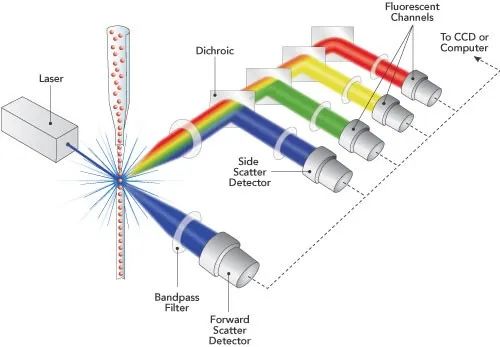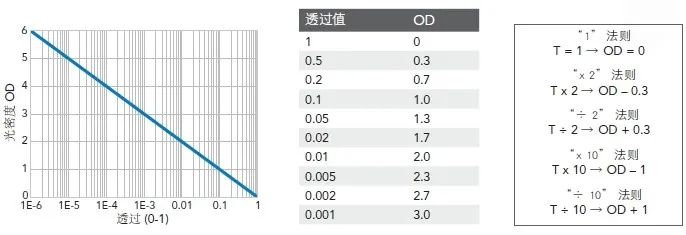Filter for flow cytometry
Flow cytometry is a technique for analyzing a large number of fluorescent labeled cells in fluids. When particles pass through a focused light source, the amount of scattered light and emission of fluorescent markers can be measured. Flow cytometry is a very important tool in basic research, used to study many aspects of cell function, and has become a very important clinical technology in the field of blood cells and cancer diagnosis.

Why consider using Semlock filter in flow cytometry?
With the development trend of high-performance flow cytometry, multiple lasers and a large number of detection channels are used at visible and near-infrared wavelengths. It is important to have appropriate filters to more completely distinguish more fluorescent groups. Semlock filters have the highest transmittance of all filters on the market, which means you can get better sensitivity. Our excellent choice of laser purification filter/laser impurity elimination filter allows you to choose ultra narrow band-pass filter for gas or DPSS lasers, or wider band-pass filter for multiple lasers or diode or optically pumped semiconductor laser systems with similar wavelengths. Its output can be from laser to laser. With temperature or aging, Semlock emission filter provides excellent laser line blocking (OD>6).
Optical density OD:
Optical Density (or OD) is a convenient tool to describe the transmissivity of light through highly blocked optical filters (when the light transmission is very small). OD is simply defined as a negative logarithmic (base 10) variable. The variable varies between 0 and 1 (OD=– log10 (T)). Therefore, the transmissivity is simply equal to the square of the negative OD value of 10 (T=10 – OD). The left figure shows the impact of OD: the transmissivity changes of 6 orders of magnitude (1,000,000 times) are simply represented by a number between 0 and 6; The following example table in the middle and the “Rules” list at the bottom right provide some convenient techniques for fast conversion between OD and transmissivity. Multiplying the variable T by 2 (or dividing by 10) equals to subtracting 0.3 (or adding 1), which is converted to OD.
Optical density background noise:
By carefully optimizing our measuring equipment and methods, Semlock can provide some optimized broadband optical density (OD). The following are typical OD noise background limits for most of the measurements displayed on this website. For wavelengths between 320 and 1120 nm, transmission values close to or below 3e-7 (optical density 6.5) are limited by measurement noise. For wavelengths<320 nm and between 1120-1500 nm, transmission values close to or below 3e-6 (optical density 5.5) are limited by measurement noise. For wavelengths greater than 1500 nm, transmission values close to or below 1e-5 (optical density 5.0) are limited by measurement noise. Similarly, for some filters and/or some blocking wavelength ranges, the background noise displayed is only OD 4.
Laser damage threshold
The degree of laser damage to the filter depends on multiple factors, so it is difficult to ensure the performance of the filter under all possible conditions. However, it is useful to determine the laser damage threshold (LDT), so that the pulse flux or intensity is lower than this threshold, it is unlikely to damage the filter.

Laser damage threshold calculator
Semlock’s laser damage threshold calculator is for reference/guidance purposes only.
The LDT calculator is not applicable when the laser damage is only a key parameter in the LIDT test. That is, this calculator is only applicable to laser as the only damage source. There are no other damage sources in the environment, such as molecular pollution, physical pollution, installation stress, temperature and other environmental variables. Most optical devices never reach the ideal LDT calculation. The LDT calculator is scaled according to the laser wavelength and pulse duration according to the nominal specification, but it should be noted that although the equation scales fairly linearly in the nanosecond range, when switched to the picosecond level, the damage mechanism changes from mainly thermal damage to electronic breakdown. Pulse duration. Finally, most optical devices will have specific areas with low laser damage threshold due to material absorption, including OH lines and low UV wavelength range.
01 What is the laser damage threshold of a product?
LDT specifications can be found on each product page under the heading “Optical Damage Levels” on the Specifications tab. Or use the calculator to select the corresponding product family from the first drop-down menu “Product Family”. The laser damage threshold of this series of products will appear on the right side of the calculator page.
02 How to use the laser damage threshold LDT calculator?
The Semlock filter with IBS ion beam sputtering hard coating provides a high laser damage threshold, but this does not mean that it can accept unlimited laser intensity. More importantly, you need to calculate the spot size for safe use and use it within this range. Use this LDT laser damage threshold calculator, which belongs to laser type, power and other parameters, and then try to change the size of the spot used until a green safety signal appears.
03 How do different types of lasers cause filter damage?
Pulse laser vs. CW laser: pulse laser in a series of durations τ The pulse of is emits light with repetition rate R and peak energy Ppeak, and the cw laser emits stable beam with constant power P. The average pulse laser power Pavg and the constant continuous laser power of most lasers are usually between a few milliwatts (mW) and watts (W). The table at the end of this note summarizes the key parameters used to characterize the output of the pulsed laser.
The following table outlines the conditions under which laser damage is expected to occur for the three main types of lasers
Unit: Watts for P; Hz for R; Diameter in cm; LDTLPin J/cm2.
Note: lspec and tspec are wavelength and pulse width respectively, in which LDTLP has been specified.
*The situation of continuous wave laser and quasi continuous wave laser is rough estimation and is not taken as guarantee specification.
Long pulse laser:
The damage threshold of long pulse is usually specified according to the pulse density of “long pulse laser”. Because the time between pulses is so large (milliseconds), the irradiated material can be thermally relaxed – so damage is usually not thermally induced, but is caused by almost instantaneous dielectric breakdown. Usually, the result of damage is the surface or volume defects of the material and the nearby irregular light field characteristics. Semlock filter LDTLP 1 J/cm2, so it is considered as a “high power laser quality” component. An important exception is the narrowband laser line filter, whose internal field strength is strongly concentrated in several thin film coatings, resulting in about one order of magnitude smaller LDTLP.
Continuous laser:
The damage of cw laser is usually caused by thermal (heating) effect. For this reason, for cw lasers, LDTCW is more dependent on the material and geometric properties of the sample. Therefore, unlike long pulse lasers, it is more difficult to specify a single quantity. For this reason, Semrock does not test or specify the LDTCW of its filter products. As a general rule, many all glass components, such as dielectric film reflectors and filters, have an LDTCW (intensity is specified as kW/cm2), which is at least 10 times the damage threshold LDTLP of long pulse laser (intensity is specified for quantification, and the unit is J/cm2).
Quasi continuous laser:
Quasi continuous laser is in the range of femtosecond (fs) to picosecond (ps), pulse width τ Pulsed laser. Moreover, the repetition rate of high-power lasers is usually around 10-100 MHz. These lasers are usually mode locked, which means that the frequency is determined by the round-trip time of the light in the laser cavity. With such a high repetition rate, the time between pulses is very short, and thermal relaxation is impossible. Therefore, in terms of LDT, quasi continuous laser is generally treated like continuous laser, using average intensity instead of continuous laser intensity.
For example, a dual frequency Nd: YAG laser with a wavelength of 532nm is assumed to have the following parameters: τ= 10ns, R=10Hz, and Pavg=1W Then D=1×10 – 7, E=100mJ, and Ppeak=10MW. For spot diameter=100 μ m. F=1.3kJ/cm2, so a product may be damaged if LDTLP=1J/cm2. However, if the spot diameter=5mm and F=0.5J/cm2, the filter product will probably not be damaged.



